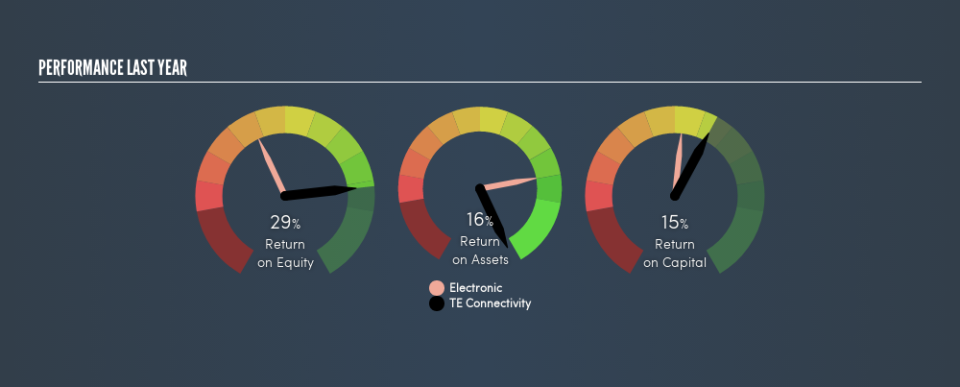Should You Like TE Connectivity Ltd.’s (NYSE:TEL) High Return On Capital Employed?

Want to participate in a short research study? Help shape the future of investing tools and you could win a $250 gift card!
Today we'll evaluate TE Connectivity Ltd. (NYSE:TEL) to determine whether it could have potential as an investment idea. In particular, we'll consider its Return On Capital Employed (ROCE), as that can give us insight into how profitably the company is able to employ capital in its business.
First of all, we'll work out how to calculate ROCE. Next, we'll compare it to others in its industry. And finally, we'll look at how its current liabilities are impacting its ROCE.
Return On Capital Employed (ROCE): What is it?
ROCE measures the amount of pre-tax profits a company can generate from the capital employed in its business. All else being equal, a better business will have a higher ROCE. In brief, it is a useful tool, but it is not without drawbacks. Renowned investment researcher Michael Mauboussin has suggested that a high ROCE can indicate that 'one dollar invested in the company generates value of more than one dollar'.
How Do You Calculate Return On Capital Employed?
Analysts use this formula to calculate return on capital employed:
Return on Capital Employed = Earnings Before Interest and Tax (EBIT) ÷ (Total Assets - Current Liabilities)
Or for TE Connectivity:
0.15 = US$2.4b ÷ (US$19b - US$3.9b) (Based on the trailing twelve months to March 2019.)
Therefore, TE Connectivity has an ROCE of 15%.
View our latest analysis for TE Connectivity
Is TE Connectivity's ROCE Good?
When making comparisons between similar businesses, investors may find ROCE useful. In our analysis, TE Connectivity's ROCE is meaningfully higher than the 12% average in the Electronic industry. I think that's good to see, since it implies the company is better than other companies at making the most of its capital. Separate from TE Connectivity's performance relative to its industry, its ROCE in absolute terms looks satisfactory, and it may be worth researching in more depth.
It is important to remember that ROCE shows past performance, and is not necessarily predictive. Companies in cyclical industries can be difficult to understand using ROCE, as returns typically look high during boom times, and low during busts. ROCE is only a point-in-time measure. What happens in the future is pretty important for investors, so we have prepared a free report on analyst forecasts for TE Connectivity.
How TE Connectivity's Current Liabilities Impact Its ROCE
Current liabilities are short term bills and invoices that need to be paid in 12 months or less. The ROCE equation subtracts current liabilities from capital employed, so a company with a lot of current liabilities appears to have less capital employed, and a higher ROCE than otherwise. To counteract this, we check if a company has high current liabilities, relative to its total assets.
TE Connectivity has total assets of US$19b and current liabilities of US$3.9b. As a result, its current liabilities are equal to approximately 20% of its total assets. Current liabilities are minimal, limiting the impact on ROCE.
Our Take On TE Connectivity's ROCE
With that in mind, TE Connectivity's ROCE appears pretty good. There might be better investments than TE Connectivity out there, but you will have to work hard to find them . These promising businesses with rapidly growing earnings might be right up your alley.
If you like to buy stocks alongside management, then you might just love this free list of companies. (Hint: insiders have been buying them).
We aim to bring you long-term focused research analysis driven by fundamental data. Note that our analysis may not factor in the latest price-sensitive company announcements or qualitative material.
If you spot an error that warrants correction, please contact the editor at editorial-team@simplywallst.com. This article by Simply Wall St is general in nature. It does not constitute a recommendation to buy or sell any stock, and does not take account of your objectives, or your financial situation. Simply Wall St has no position in the stocks mentioned. Thank you for reading.

 Yahoo Finance
Yahoo Finance 
